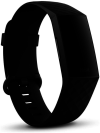A feasibility study to evaluate a purposeful walk intervention with a distance goal using a commercially available activity monitor in elderly people post total hip replacement surgery
- PMID: 37635835
- PMCID: PMC10447967
- DOI: 10.1177/20556683231195927
A feasibility study to evaluate a purposeful walk intervention with a distance goal using a commercially available activity monitor in elderly people post total hip replacement surgery
Abstract
Introduction: Total hip replacement (THR) is performed in an increasing number of individuals around the world and while improvements in pain reduction and long-term enhancement of muscle strength are well documented, the improvement in daily activity does not follow the same trend. This study aimed to determine the feasibility of a 5-week intervention where a personalised outdoor walking distance is monitored using a commercial activity monitor (Fitbit Charge 4).
Method: Data was collected on gait and activities of daily living using patient reported outcome measures. Following the completion of the intervention period, participants took part in a semi-structured interview to voice their opinion on the use of the activity monitor, their experiences, and any challenges in order to assess the feasibility of the intervention. All quantitative data were presented descriptively, using appropriate summary statistics. Interviews were analysed using thematic analysis.
Results: Five participants who had undergone total hip replacement surgery within the postoperative period of 3 to 6 months were recruited from the local community.
Conclusion: The findings suggest that the intervention was feasible and that it encouraged all participants to increase their daily activity. Therefore, it can be concluded that a follow-up effectiveness trial is warranted.
Keywords: Total hip replacement; activity monitor; gait analysis; walking activity.
© The Author(s) 2023.
Conflict of interest statement
The author(s) declared no potential conflicts of interest with respect to the research, authorship, and/or publication of this article.
Figures











Similar articles
-
Can a Purposeful Walk Intervention with a Distance Goal Using an Activity Monitor Improve Individuals' Daily Activity and Function Post Total Hip Replacement Surgery. A Randomized Pilot Trial.Cyborg Bionic Syst. 2023 Nov 30;4:0069. doi: 10.34133/cbsystems.0069. eCollection 2023. Cyborg Bionic Syst. 2023. PMID: 38435675 Free PMC article.
-
Erratum.Mult Scler. 2016 Oct;22(12):NP9-NP11. doi: 10.1177/1352458515585718. Epub 2015 Jun 3. Mult Scler. 2016. PMID: 26041800
-
A behaviour change intervention to reduce sedentary time in people with chronic obstructive pulmonary disease: protocol for a randomised controlled trial.J Physiother. 2017 Jul;63(3):182. doi: 10.1016/j.jphys.2017.04.001. Epub 2017 May 16. J Physiother. 2017. PMID: 28526329
-
Improving community ambulation after hip fracture: protocol for a randomised, controlled trial.J Physiother. 2017 Jan;63(1):45-46. doi: 10.1016/j.jphys.2016.10.001. Epub 2016 Oct 28. J Physiother. 2017. PMID: 27964962 Free PMC article. Clinical Trial.
-
Gait Training Using the Honda Walking Assistive Device® in a Patient Who Underwent Total Hip Arthroplasty: A Single-Subject Study.Medicina (Kaunas). 2019 Mar 14;55(3):69. doi: 10.3390/medicina55030069. Medicina (Kaunas). 2019. PMID: 30875846 Free PMC article.
Cited by
-
Can a Purposeful Walk Intervention with a Distance Goal Using an Activity Monitor Improve Individuals' Daily Activity and Function Post Total Hip Replacement Surgery. A Randomized Pilot Trial.Cyborg Bionic Syst. 2023 Nov 30;4:0069. doi: 10.34133/cbsystems.0069. eCollection 2023. Cyborg Bionic Syst. 2023. PMID: 38435675 Free PMC article.
References
-
- National Joint Registry, N . National joint registry 19th annual report. London, UK: National Joint Registry, N, 2022. - PubMed
-
- Beswick AD, Wylde V, Gooberman-Hill R, et al. What proportion of patients report long-term pain after total hip or knee replacement for osteoarthritis? A systematic review of prospective studies in unselected patients. BMJ Open 2012; 2(1): e000435. DOI: 10.1136/bmjopen-2011-000435 - DOI - PMC - PubMed
LinkOut - more resources
Full Text Sources

